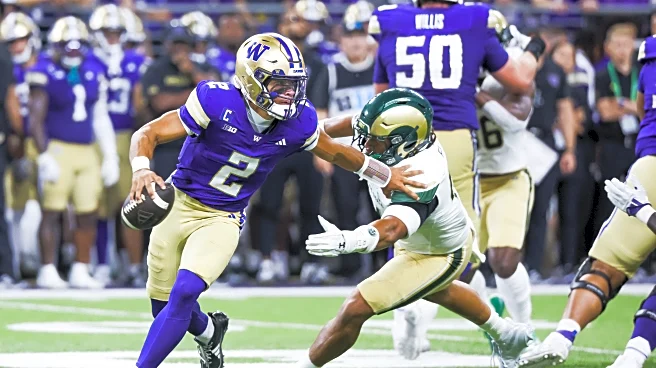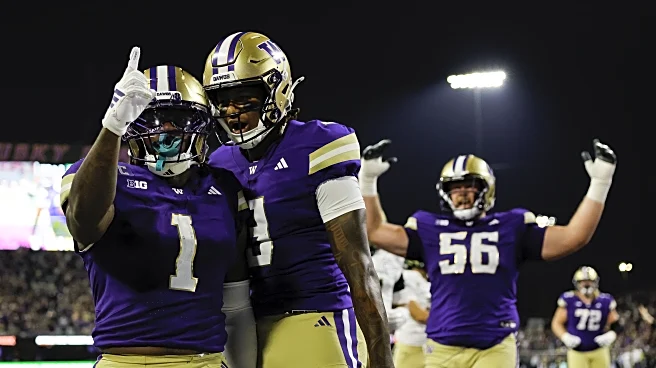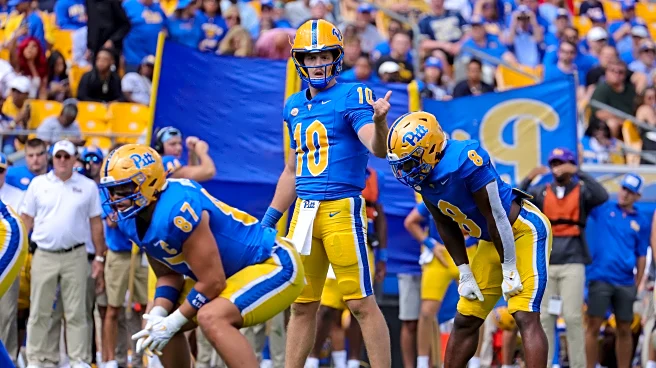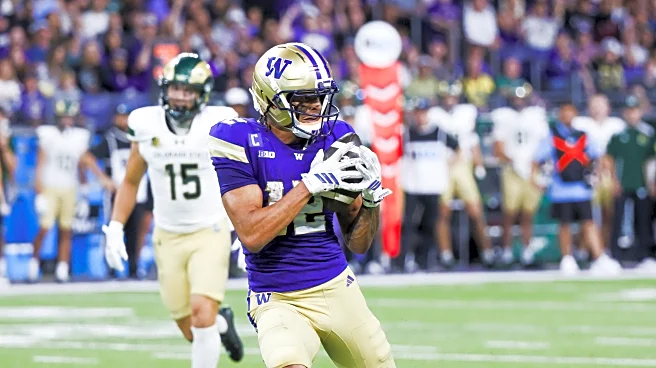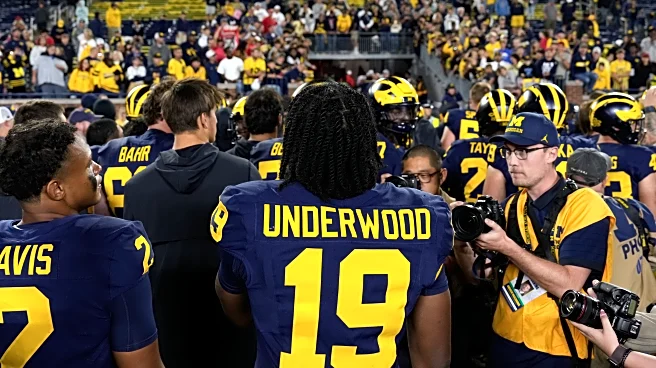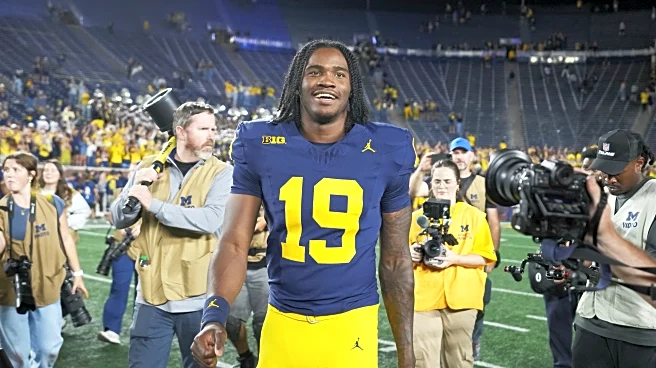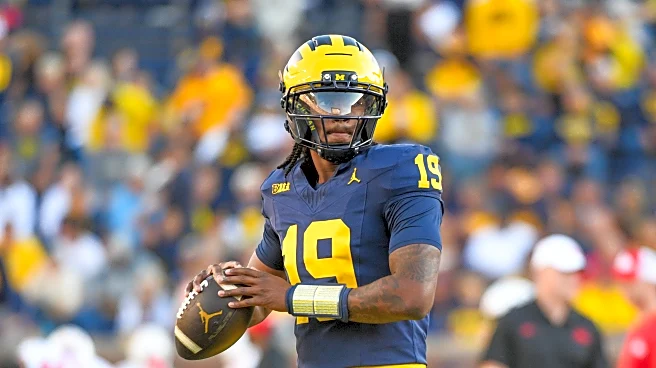

Welcome back Dawg fans to the best time of the year!
Year 2 of the Fisch and B1G Era kicked off on a high note, with your Huskies taking down the Colorado State Rams 38-21 on Saturday night. There were some shades of 2021 in the first half but the team flipped the switch in the second half, led by some timely stops on defense. The trio of Demond x Jonah x Denzel stuffed the stat sheet, showing what is hopefully in store for UW this season. Fans packed The Greatest Setting for yet another highly anticipated
season, as the team retooled in the offseason in hopes of making a bigger splash in their new conference and maybe even a College Football Playoff berth.
To the Film –
Note from Coach B: For this week’s Film Study, I wanted to lean on “the Good, the Bad, and the Ugly” format to paint the picture of what I took away from the tape. There were four points I wanted to make instead of three, and Bad vs. Ugly is subject to interpretation, but I digress. Anyways, onwards.
The Good – Rushing Attack
Jonah Coleman is a capital “D” Dude. We already knew that from last year, but after slimming down and healing up this offseason, Coleman kicked off a potential dark horse Heisman campaign with a 177 yard rushing, 286 all-purpose yard performance behind a retooled offensive line. He looks faster and more decisive this season, and the line looks substantially more physical up front. Even with a solid Zone run scheme last year (despite our blocking issues at times), Fisch & Co. clearly spent some time during the offseason cooking up new wrinkles to keep things fresh. My favorite was this one below that got called a few times with explosive results: Split Zone with Front Side Escort Motion.
1st Quarter – 11:10 – 2nd & 8

To kick off the game’s scoring, we first dialed up this Split Zone wrinkle out of an under center 11 personnel formation for a 21-yard TD. Last year, we had a sizable under center package that featured a play action passing package that was built around the Split Zone run concept, so this is more of a variation or added layer to that package than a new addition. The Split Zone concept itself is a variation on the ubiquitous Inside Zone concept where a frontside blocker (typically an H-Back/Fullback) pulls to the backside to kick out the backside EDGE. Standard Split Zone introduces Gap run elements, such as cross-formation blocks (the H-Back slice block, or in this case, #86 Decker DeGraaf) to insert additional gaps backside, thereby placing horizontal stress on the second level LBs’ gap integrity, but it also utilizes auxiliary blockers to create cutback lanes without tampering with the flexible zone blocking assignment rules that the OL has. This is already a solid run concept that many teams have successfully implemented and have added bells and whistle window dressing to, but this may be the first time I’ve seen this Escort Motion wrinkle tagged to it in this manner.
Escort Motion is a relatively recent trend across football over the last three or four years, primarily being popularized by Kyle Shanahan’s 49ers and Sean McVay’s Rams in the NFL. Basically, it’s a motion that brings a perimeter player in motion pre-snap to act as a lead blocker, or “escort”, on a run play. Often times it is used to allow a player to build momentum pre-snap on a quick hitting run play, or to build momentum to deliver a crushing block, but when utilized in this particular formation and concept, it can have other ancillary schematic benefits. In this case, we can disguise the Escort Motion as Jet Motion since Jet Motion looks similar pre-snap and is often paired with Zone runs as a backside constraint to keep the backside contain honest. Let me repeat that. Jet Motion is usually paired with Zone runs to hold the backside. Instead, on this play, we’re running Escort Motion towards the frontside and using #7 Raiden Vines-Bright as a lead blocker to kick out the front side Force defender. Imagine the contain defender’s surprise when he held up anticipating having to play contain against the motion only for RVB to plow right into him for the kickout.
We should also take a moment to think about the eye discipline and gap integrity stress all of this backfield action creates for the defense. The H-Back slice block to the left draws the safety (#18) and the frontside CB (#4) away from the point of attack, thereby leaving just the nickel (#2) as the force defender (responsible for setting the edge) 1v1 with RVB on the kickout. Once RVB neutralizes #2, the only defender left to make the tackle is #13 who is in trailing position traveling with RVB’s motion, which is way easier for Coleman to evade than an unblocked force defender.
Finally, we need to address Coleman’s vision being a key factor in this play. Between the H-Back slice block on the Split Zone action and the kickout block from RVB’s Escort Motion, we have cross-formation blocks creating creases on both sides of the blocking front for Coleman to choose from. That’s a lot for a RB to process quickly. Typically, you would really want to limit your RB to reading 2 or 3 adjacent gaps to hit on a Zone run play depending on the flow of the defense. However, we’re asking Coleman to read the first and second level flow to chose between two run lanes five gaps apart. That’s tough, but Coleman reads the flow correctly, makes a jump cut and outruns the trailing defenders for a TD. Great play design and great execution up front.
2nd Quarter – 7:06 – 2nd & 7

Same concept and set up as the first play, but this time run to the left. I wanted to feature this play to emphasize how the same play call can be executed differently depending on how the defense lines up against it, which is the beauty of Zone-based run concepts. On this play, the Ram defense is lined up in the same basic personnel and 5-man “Mint” front, but their front side CB’s alignment is slightly different. Instead of playing up on the line with another overhang defender to the outside, like in the first play, CSU has their CB backed off the line. This means that the play side WR, #3 Rashid Williams, is going to run him off the line and execute a stalk block instead of engaging him immediately. This clears the outside overhang defender (again, on this play CSU doesn’t have another overhang defender outside of Williams’ guy), and LT Carver Willis just needs to pick up the OLB/EDGE defender to spring Coleman for a nice gain. Given the OLB/EDGE’s alignment, Willis isn’t able to seal the edge for Coleman, but he is able to widen the B-gap for Coleman to cut inside.
Coleman sticks to his coaching to get north/south quickly once he cuts behind Willis’ block, but he did also have Audric Harris’ lead block to the outside with no one but the trailing CB to beat. That might’ve had an opportunity for an even more explosive run, but it’s hard to complain about a 16-yard run behind a dressed up base run play.
The “Bad” – 3rd Down Passing Situations
One area that wasn’t so great against Colorado State, despite it being one of our known areas for improvement this offseason was our passing situation execution. By my count, we faced seven 3rd & long (5+ yards to go) situations and we converted just two of them. Granted, one of the failed attempts was DOA due to a botched snap operation, and the two times that we did convert we got explosive plays out of it. However, it certainly felt like we’re in a boom or bust pattern for these passing situations with more busts than we’d like. When you also factor in that our passing game was fairly pedestrian in this game, just four explosives (20+ yard gains) making up ~50% our passing total and two of those four coming on screens/RB checkdowns, it leaves me wondering if this is a single game anomaly or the blueprint for future opponents to gameplan around.
We have solid receiving threats in Denzel Boston, Decker DeGraaf, and Rashid Williams, but we seemed to lack a consistent YAC or vertical threat from the WR or TE positions against CSU. We know Demond is a capable downfield passer, so it begs the question of why we struggled to consistently generate explosives in the passing game. One common comment I saw around the interwebs was that Demond took too many avoidable sacks, and while two of the four unsuccessful 3rd & long situations resulted in sacks, I’m not sure how much of that was on Demond or any of the other players executing.
1st Quarter – 2:01 – 3rd & 10

First up, we have Demond’s sack from the first quarter. We’re in 3rd & long on the CSU 27-yard line. Situationally, we’re just inside scoring position, so we have to be thinking no negative plays that might force us out of field goal range. We’ve got 11 personnel lined up in a 3×1 “Nub” formation with the 3 WRs to the field and DeGraaf at the Y-TE spot to the boundary. This formation appeared to be one of Fisch’s preferred passing down formations against CSU since it uses personnel alignment to force the defense to tip their coverage hand while also affording the offense with the option of utilizing 7-man protections that include both the TE and RB.
Pre-snap, CSU tries to disguise their coverage, but they are hinting at a single-high shell with man coverage underneath given how they line up their DBs against the trips to the field. Against this, Fisch has a 3-route concept paired with a 7-man full line slide protection with Coleman picking up the blind side blitz. I’ll be honest that I don’t entirely know what passing concept Fisch was going for on this play. It looks like Boston is setting up to either run off or block the outside CB for Williams to run an outbreaking route underneath, and then we also have a Drag route coming across the middle from the WR3 spot. The problem is that I don’t see Boston or Williams looking back for the ball until well after Demond is under duress, and the Drag route is well-covered by the DB. It looks like Demond was expecting one of those two to be on a quick route, but with no one ready for the pass, Demond has to double clutch and takes the sack.
In theory, we should’ve had enough blockers in the 7-man protection to pick up the blitz, but Fisch is still rolling the dice. Fewer routes equals fewer options for Demond to get the ball out to, and more blockers against more rushers just means that there are more 1v1s that might not go our way.
I simply don’t understand the thought process on this play call/design to really blame the players, so by default I’m going to question Fisch and the staff for this one.
2nd Quarter – 5:46 – 3rd & 13

On the other hand, this sack from the 2nd quarter isn’t entirely on the play call, even if it’s not great. This time were running another 3-route concept, this time its Verts, with another 7-man full slide protection. This time, CSU does a better job concealing their coverage by showing a 2-high shell but then bailing into a single high Cover 1 look that double teams Boston. The Rams also have a “Green Dog” blitz called where the LBs are rushing once they read that the RB and TE that they’re responsible for are staying in to block. This time, the line does a pretty good job blocking the blitz even though the delayed pressure eventually gets Demond.
Yet again, with no immediate check down options, this time not even a designed quick option that got covered, Demond is stuck trying to figure out how to make lemonade out of a lemon. Unfortunately, there’s only so much he can do without many options, and he rather prudently takes the sack instead of forcing an ill-advised pass into coverage. I’m not super impressed by the WRs and their inability to get separation in man coverage, but at the same time, the play call is running them right into a coverage that’s bracing for the deep pass.
I would’ve expected Fisch to mix the play calling up a bit to see if we could get some YAC against the man blitzes after seeing how poorly the first 7-man protection sack went, but hindsight is 20/20.
The “Also Very Much Not Great” – Passing Down Defense
If you were like me and Awgs and watched the game live, you probably walked away under the impression that CSU’s conversion rate was much higher than it was and UW’s was much lower than it was, and that was probably because of the 3rd & long conversion rates. Whereas our Huskies were 2/7 on 3rd & long, the Rams were something like five long 3rd or 4th down conversions. Of course, that’s five long conversions out of 18 combined 3rd/4th down attempts (compared to UW’s 9/15), but those types of conversions still represent demoralizing blows to the defense.
While there were issues with some of our coverage calls in those high-leverage situations, the reason why I’m categorizing this as “Also Very Much Not Great” instead of “Ugly” was that their last TD really shouldn’t have been a TD, like Fisch said post-game. Anyways, let’s take a look at a couple of these plays to figure out what happened.
3rd Quarter – 8:43 – 3rd & 19

Here on a 3rd & 19 play, CSU sets up this play by lining up in an 11 personnel shotgun 2×2 formation before motioning into a 3×1 FIB (formation into boundary) look. Against this look, we’re running our typical 4-2-5 nickel personnel with Makell Esteen playing deep in a single high coverage shell. CSU runs a Verts concept with the motion man running a Drag route as the checkdown option, and their QB rifles a pass up the seam to a wide open TE for the long conversion.
So what happened here? Well based on the defense’s pre-snap adjustment to the motion and the post-snap coverage drops, I think it’s safe to say that we had a Cover 3 zone call on this play. I had been paying attention to our reaction to motion throughout the game, and early on we were traveling players across the formation when in man coverage (standard practice), but by the second half, we were bumping guys over or rolling safeties as we ran more zone coverages. On this play, we again bumped our coverage over while running a zone coverage, which you can see if you watch Buddah Al-Uqdah (#3) sliding over towards the boundary to cover the motion man and Leroy Bryant (#0) staying to the field despite only having one receiver to that side.
So what does that mean? Well, now that we know that we were running a single-high shell and zone underneath, we know that we were probably running a version of Cover 3 (the most common single-high zone coverage). There are three basic varieties of Cover 3 (Sky, Buzz, and Cloud) with additional tags and adjustments that can be applied based on what the offense shows. Sky, Buzz, and Cloud refers to the player that is responsible for the strong side flat zone. Sky = Strong Safety, Buzz = Backer, and Cloud = CB. You can get a more in-depth explanation of the Cover 3 basics here if you’re interested, but we can assume that it’s probably Cover 3 Sky since safety Alex McLaughlin (#12) is rotated down towards the flat pre-snap.
Now the key to diagnosing what went wrong on this play is figuring out what our adjustment was to the motion into a 3×1 FIB look. Basic Cover 3 is designed around 2×2 formations, so every defense that runs Cover 3 needs an adjustment call to handle 3×1 formations where the offense can flood the standard Cover 3 zones if not adjusted for. One of the most common adjustments, and the one that I think we used, is the “Mable” call. Mable locks the CB over the solo receiver in man coverage (which it looks like based on #7 Prysock’s technique) while shifting the rest of the coverage towards the trips side. This means that the trips side CB still maintains deep coverage responsibility (especially against that side’s WR1), DB/LB2 (McLaughlin) has WR2 vertical or the flat, and DB/LB3 (Al-Uqdah) has WR3 to the outside or gets the hook zone just inside the hash.
Assuming that this is the coverage call, I think where the play broke down was in establishing who was the WR2 vs. WR3 in the formation. When CSU motioned #10 to the boundary, they aligned him in a stack look behind their TE #19. Since it wasn’t clear who was WR2 or WR3, I think McLaughlin and Al-Uqdah got their wires crossed as to who was supposed to carry the TE up the seam. It can be a confusing look to diagnose and get communicated to the rest of the defense on the fly, and it shouldn’t be difficult to get fixed moving forward. The scheme check was sound, and I think the players knew their assignment, but execution matters. Especially when we’re sitting back in coverage without a ton of pressure being generated, but that’s a topic for another day…
3rd Quarter – 8:06 – 1st & 10

I’ll keep this one short and to the point. This play shouldn’t have been a TD, and it should’ve been called back for an illegal formation/ineligible receiver penalty. I assume that a bunch of you reading this probably already heard or read Fisch’s commentary on this play from his post-game interview, but I figured it’d be good to show you a visual to better understand it.
The NCAA formation rules dictate that seven offensive players must line up on the line of scrimmage with only the outside two being eligible receivers. Additionally, the offense may have no more than four players in the “backfield” (or not on the line of scrimmage). Clearly CSU has three players in the traditional backfield (QB, RB, and #12 in motion), at which point then you have to look to their three players to the top of the screen to see who is on the line versus off the line and in the “backfield.” A quick glance would suggest that their WR2 is clearly on the line and lined up in front of their TE #19 and the outside WR. If that is how CSU intended to line up (6 on the line and 5 in the backfield), then that’s an illegal formation with 5 in the backfield.
Now, I think that CSU was trying to be tricky with their formation by playing around with eligible vs. ineligible receivers. Technically, they could’ve put their WR1 on the line of scrimmage as well to avoid the illegal formation penalty. This would’ve made their WR2 an ineligible decoy, and given that he’s just blocking behind the line post-snap, I think it’s safe to say that that’s what they were trying to do. However, since the outside WR1 is off the line, it still should’ve been an illegal formation penalty.
Now, Fisch did also mention that Prysock got his assignment confused or there was some sort of miscommunication on the field since he let the TE go anyways. If the WR1 was on the line, the TE would’ve still been an eligible receiver, so there’s no real reason for Prysock to have let him go uncovered.
This shouldn’t have been a TD based on a technicality, but there’s still a coaching point to get worked on this week anyways.
The “Ugly” – 1st Half Rushing Defense
Yeah, the optimist in me is thinking that we made the right adjustments in the second half to shut down their rushing attack (negative yardage allowed in the 2nd half), but the pessimist in me thinks that our first half performance was all too familiar.
11 carries for 80+ yards in the first half doesn’t bode well for our defense if we look ahead to Big Ten conference play. I know Ryan Walters mentioned in his interview this week that the Rams’ backup QB/Gadget player, Tahj Bullock, added a wrinkle to the CSU offense that they hadn’t put on film, but what they ran with him wasn’t brand new concepts. Plus, there were any number of big plays on the ground where he wasn’t even on the field. Let’s take a look.
1st Quarter – 9:56 – 1st & 10

First up, we have this 20-yard run from their RB Dupree on a GH Counter run play on their first scoring drive. CSU sets this play up with 12 personnel lined up in a heavy shotgun formation with a Y-TE to the play side and their other TE lined up as a H-Back to the backside. Against this, we’re playing base personnel (3-4/5-2 depending on how you count the EDGEs) lined up in a 5-2 “Mint” Odd front with a single-high shell behind it. The root problem on this play run fit execution.
Counter, like Power, is a gap run that uses pulling blockers from the backside to create new gaps and a numbers advantage at the point of attack. The only way to defend against gap run concepts is to match numbers at the point of attack or to leverage two-gapping and block destruction to earn numbers at the point of attack. Even with stud DL, its not always a sure thing for a defense to stop a gap run without flowing LBs making the stop by plugging gaps.
On this play, we have an 8-man box if you include Tacario Davis (#8) in the box count against CSU’s 7 blockers. On paper, we should have an unblocked defender in the box who can make the tackle assuming that everyone else takes up just one blocker. The challenge, while not insurmountable, is that the blocking scheme is designed to make that unblocked defender be as far away from the point of attack as possible to improve the odds that the RB can get into the open field before the defender can flow to plug the gap. On this play, Buddah Al-Uqdah, the backside LB, is the unblocked box defender. He has the speed and instincts to make the play, but he gets stuck in the wash and the traffic of the play and isn’t able to make the tackle before Dupree gets the big run. However, just because Al-Uqdah couldn’t make the play as the unblocked defender doesn’t mean we didn’t have other opportunities to make a stop earlier.
Up front, we’re playing a Mint Front, which means that we’re playing our DL “head up” or on the inside shoulder of the OTs and have our EDGEs playing outside the last players on the LOS (the TEs in this case). The Mint Front is designed to protect the LBs from the OL on inside runs, but Counter plays, especially those with TEs on the front side, can attack the “bubble” (an unfilled gap) between the DL and the EDGE. The front side TE makes a good block on Deven Bryant (#17) which also impedes Al-Uqdah’s flow to the point of attack. Durfee does his job as the play side EDGE by squeezing the kickout block from the OG, but neither Bryce Butler (#92) nor Davis can beat their blocks to get a hand on the RB at the point of attack. I don’t really want to blame Davis for not beating CSU’s 6-5 250lb TE in the hole (also, let’s take a moment to appreciate that the TE’s name is Rocky Beers), and I kind of get that Butler’s primary task is to eat blocks and protect the B-Gap and not the C-Gap, but that’s what we’re going to be facing in conference play.
The run fit was designed just fine, but the execution just wasn’t there. My only thought would be potentially adjusting the run fits to force runs outside and protect the LBs even better, but there’s no guarantee that that’d work either.
1st Quarter – 7:10 – 1st & 10

Later on the same drive, and again without Bullock on the field, CSU gets another big run using a staple option concept that we’re likely to face in Big Ten play: Inverted Veer.

Inverted Veer is an option concept based on the One-Back Power blocking scheme. Unlike a conventional Veer play where the QB is reading the front side EDGE to determine if he should give the ball to the RB on the dive or to keep the ball round the edge, the QB is instead making the same read to determine if he should keep the ball on the dive or give it on a sweep.
The challenge we had with defending this play was that we have a 6-man box defending against a 5-man blocking surface that gets a +1 “block” from the QB since he’s reading one of the 6 box defenders and should neutralize one of those defenders with his read. Plus, since the Inverted Veer concept utilizes a pulling blocker, the offense will have even better numbers at the point of attack. What all this means is that we’re either forced to make a tackle with a non-box defender (likely after a big gain), or we need one of our box defenders to even the numbers by neutralizing multiple blockers to free up one of the other box defenders. Some how CSU was able to get double teams on both of our DTs while driving one of them into one of our LBs (thereby neutralizing him as a flow defender), and neither of our EDGEs were in a position to make a tackle because they were either the chase down/contain defender on the backside of a perimeter run (Durfee) or the read defender (Lane).
Like the run play before, I’m not entirely sure how the staff plans to defend this type of option moving forward. Maybe they’ll adjust run fits to funnel everything back inside where there’s a better chance to stuff the run with traffic. Maybe they’ll only spill runs when we have our CBs in zone coverage and can keep eyes in the backfield as extra overhang defenders. Maybe we’ll improve naturally once we get Sagapolu and Lynch back from injury. All I know is that right now, I don’t think we have the players up front that can make a stop without a +1 box count.
Awgs’ Bonus Play:
This season starts off with QB1 showing off his wheels, being an absolute ‘Speed Demond’ against the defense.

Insert Chris Berman’s “Whoop!” (I couldn’t find a clip with just the Berman “Whoop!”, so enjoy my substitute sound track to this highlight, see below).
